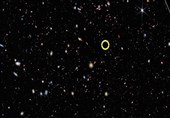Astronomers Discover Unique Radio Galaxy with Peculiar Features
TEHRAN (Tasnim) – Using the Low-Frequency Array (LOFAR), astronomers have identified a new radio galaxy, J0011+3217, characterized by an unusual one-sided secondary lobe.
This discovery was detailed in a research paper published on June 21 on the pre-print server arXiv.
Radio galaxies emit immense amounts of radio waves from their central cores. Black holes at the centers of these galaxies attract gas and dust, producing high-energy jets visible in radio wavelengths, which accelerate electrically charged particles to high speeds.
Typically, during its active phase, which can last up to 100 million years, a radio galaxy displays features such as a core, lobes, jets, and hotspots. After this active phase ends, these features generally disappear as the galaxy's active galactic nucleus (AGN) shuts down, leading the galaxy into a remnant or dying phase.
A team of astronomers led by Shobha Kumari of Midnapore City College in India has now reported the detection of such a radio galaxy with lobes. "From the LOFAR Two-meter Sky Survey second data release (LoTSS DR2) at 144 MHz, we identified a peculiar radio galaxy, J0011+3217," the researchers noted in the study.
According to the paper, J0011+3217 is a giant radio galaxy featuring a one-sided secondary lobe and misaligned giant primary lobes. The newfound galaxy appears to be associated with the galaxy cluster Abell 7.
LOFAR observations reveal that the secondary lobe spans approximately 2.77 million light years, which is about 85% the size of the primary lobe. Such one-sided secondary lobes are extremely rare, with only a few known cases in some X-shaped radio galaxies.
The astronomers emphasize the significant size of the one-sided secondary lobe in J0011+3217, noting that such features are usually more than four times smaller than the primary lobes. A giant one-sided secondary lobe like the one in J0011+3217 has never been observed in any other X-shaped radio galaxies.
The study also found that J0011+3217 shows minor distortions or off-axis diversions. This bending in the jet is more common in wide-angle tails (WATs), which are powerful, bent radio sources typically associated with the dominant galaxy in a cluster or group.
Summing up the results, the authors stress the necessity for further studies of J0011+3217 to fully understand its peculiarities. "To measure the detailed parameters and study the conditions under which this peculiar radio galaxy J0011+3217 forms, further studies, including simulations and optical follow-up observations, will be encouraged," the researchers conclude.






